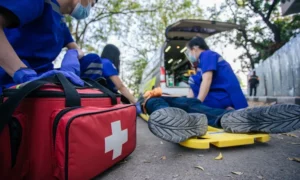Bicycle commuting is a growing trend, offering numerous benefits for health, the environment, and even productivity. However, hit-and-run accidents involving cyclists can leave employees physically injured and emotionally distressed. Employers play a crucial role in supporting their staff in the aftermath of such incidents.
For those involved in bicycle accidents, pursuing bike accident injury claims can provide essential financial support for medical expenses and recovery.
Immediate Support and Assistance
When a bicycle commuter is involved in a hit-and-run accident, immediate support from their employer is vital. Employers should ensure that the injured employee receives prompt medical attention. Arranging transportation to a medical facility and ensuring that the employee is safe should be the top priority. Employers can also offer to inform the employee’s family members or emergency contacts about the incident.
In addition to medical support, emotional assistance is crucial. Employers can provide access to counseling services or employee assistance programs (EAPs) to help the injured cyclist cope with the trauma. Offering paid leave or flexible working arrangements can give the employee time to recover without the added stress of financial insecurity or job instability.
Facilitating Bike Accident Injury Claims
Employers can assist their employees in navigating the complex process of filing bike accident injury claims. Providing information on how to document the accident, gather necessary evidence, and submit claims can significantly ease the burden on the injured employee. Encouraging employees to keep detailed records, including medical reports and any witness statements, is essential for building a strong case.
Employers can also connect employees with reputable legal professionals who specialize in bike accident injury claims. Legal experts can help injured cyclists understand their rights, negotiate with insurance companies, and secure fair compensation for their injuries and losses. Providing this support can make a significant difference in the employee’s recovery and financial stability.
Creating a Supportive Workplace Environment
A supportive workplace environment can make a substantial impact on an injured employee’s recovery process. Employers should foster a culture of empathy and understanding, ensuring that colleagues are aware of the situation and can offer their support. Simple gestures, such as checking in on the injured employee or offering to assist with work-related tasks, can help them feel valued and supported.
Additionally, employers should promote a safe commuting environment by providing secure bike parking, well-lit facilities, and access to showers and lockers. Offering safety training and resources, such as reflective gear or bike lights, can also encourage safer commuting practices and reduce the risk of future accidents.
Implementing Safety Policies and Training
Proactive measures to prevent bicycle accidents are equally important. Employers can implement comprehensive safety policies that promote safe cycling practices. Regular safety training sessions can educate employees about road safety, the importance of wearing helmets, and strategies for avoiding common hazards.
Providing resources, such as maps of safe cycling routes and information on local bike laws, can empower employees to make informed decisions about their commuting routes. Employers can also collaborate with local authorities to advocate for better cycling infrastructure and safer roads, creating a safer commuting environment for all cyclists.
Encouraging Reporting and Follow-Up
In the event of a hit and run accident, encouraging employees to report the incident promptly is crucial. Employers should have a clear reporting process in place, making it easy for employees to document the accident and receive immediate assistance. Following up with the injured employee regularly can demonstrate genuine concern and support their recovery journey.
Employers should also review the circumstances of the accident to identify any patterns or areas where additional safety measures could be implemented. This proactive approach not only helps the injured employee but also enhances the overall safety of the workplace for other bicycle commuters.
Providing Financial Support
In addition to helping employees file bike accident injury claims, employers can offer direct financial support. This can include covering medical expenses not covered by insurance, providing short-term disability benefits, or offering financial counseling to help the employee manage their finances during recovery.
By alleviating the financial burden associated with recovery, employers can help injured employees focus on healing. Financial support can also mitigate the stress and anxiety that often accompany medical bills and lost wages, contributing to a smoother and more successful recovery process.
Promoting a Culture of Safety
Creating a culture of safety within the workplace extends beyond immediate support and proactive measures. Employers should encourage open communication about safety concerns and suggestions for improvement. Establishing a safety committee or appointing a safety officer can help maintain a focus on safety and ensure that policies and practices are regularly reviewed and updated.
Recognizing and rewarding employees who consistently follow safety protocols and contribute to a safe commuting environment can further reinforce the importance of safety. By promoting a culture of safety, employers can help prevent accidents and ensure that all employees feel secure and supported in their commuting choices.
Long-Term Recovery and Reintegration
Supporting an employee’s long-term recovery and reintegration into the workplace is crucial. Employers should work with the injured employee to develop a return-to-work plan that accommodates their physical and emotional needs. This may include modified duties, part-time hours, or additional breaks to manage pain and fatigue.
Regularly reviewing and adjusting the return-to-work plan as the employee’s recovery progresses ensures that they are not overwhelmed and can gradually resume their responsibilities. Providing continuous support and understanding during this period fosters a positive and inclusive workplace environment.
Promoting Mental Health and Well-being
The psychological impact of a hit-and-run accident can be profound, leading to issues such as anxiety, depression, and post-traumatic stress disorder (PTSD). Employers should prioritize mental health by offering resources and support specifically tailored to addressing these challenges. Providing access to mental health professionals, support groups, and stress management programs can significantly aid in the emotional recovery of the affected employee.
Fostering a workplace culture that emphasizes mental health and well-being can encourage employees to seek help without stigma. Regular mental health awareness initiatives and training sessions can equip employees and managers with the tools to recognize and address mental health concerns.



































